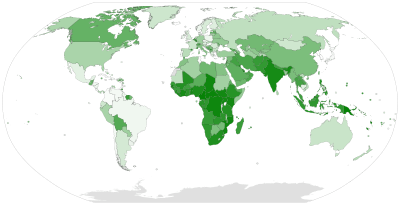Linguistic diversity index
Linguistic diversity index (LDI) may refer to either Greenberg's (language) Diversity Index[1] or the related Index of Linguistic Diversity (ILD) from Terralingua, which measures changes in the underlying LDI over time.[2]

Greenberg's Diversity Index (LDI) is the probability that two people selected from the population at random will have different mother tongues; it therefore ranges from 0 (everyone has the same mother tongue) to 1 (no two people have the same mother tongue).[3] The ILD measures how the LDI has changed over time; a global ILD of 0.8 indicates a 20% loss of diversity since 1970, but ratios above 1 are possible, and have appeared in regional indexes.[4]
The computation of the diversity index is based on the population of each language as a proportion of the total population. The index cannot fully account for the vitality of languages. Also, the distinction between a language and a dialect is fluid and often political. A great number of languages are considered to be dialects of another language by some experts and separate languages by others. The index does not consider how different the languages are from each other, nor does it account for second language usage; it considers only the total number of distinct languages, and their relative frequency as mother tongues.[5]
Rankings by country
| SIL International (2017)[6] | UNESCO (2009)[7] | |||||||||||||||||||||||||||||||||||||||||||||||||||||||||||||||||||||||||||||||||||||||||||||||||||||||||||||||||||||||||||||||||||||||||||||||||||||||||||||||||||||||||||||||||||||||||||||||||||||||||||||||||||||||||||||||||||||||||||||||||||||||||||||||||||||||||||||||||||||||||||||||||||||||||||||||||||||||||||||||||||||||||||||||||||||||||||||||||||||||||||||||||||||||||||||||||||||||||||||||||||||||||||||||||||||||||||||||||||||||||||||||||||||||||||||||||||||||||||||||||||||||||||||||||||||||||||||||||||||||||||||||||||||||||||||||||||||||||||||||||||||||||||||||||||||||||||||||||||||||||||||||||||||||||||||||||||||||||||||||||||||||||||||||||||||||||||||||||||||||||||||||||||||||||||
|
See also
- Ethnologue
- List of official languages by state
- Number of languages by country
Notes and references
Notes
- Including New Caledonia, a French Overseas Territory with a high level of Linguistic Diversity Index
References
- Greenberg, Joseph H. (1956). "The Measurement of Linguistic Diversity". Language. 32 (1): 109–115. doi:10.2307/410659. JSTOR 410659.
- Harmon, David; Loh, Jonathan (2010). "The Index of Linguistic Diversity: A New Quantitative Measure of Trends in the Status of the World's Languages" (PDF). Language Documentation and Conservation. http://nflrc.hawaii.edu/ldc. 4: 97–151. hdl:10125/4474. External link in
|publisher=(help) - "Summary by country". Ethnologue. 1999-02-19. Retrieved 2013-09-05.
- Harmon, David; Loh, Jonathan (2010). "The Index of Linguistic Diversity: A New Quantitative Measure of Trends in the Status of the World's Languages" (PDF). Language Documentation and Conservation. http://nflrc.hawaii.edu/ldc. 4: 106–107. hdl:10125/4474. External link in
|publisher=(help) - "overview of Linguistic Diversity". terralingua.org. Archived from the original on 2013-05-21. Retrieved 2014-11-18.
- Data published in Ethnologue: Languages of the World, Twentieth Edition. Summary by Country | Ethnologue, SIL International. Accessed on 13 October 2017.
- UNESCO World Report – Investing in Cultural Diversity and Intercultural Dialogue
External links
- Terralingua's Index of Language Diversity is a dead link, but similar information is available from the same site at
- https://web.archive.org/web/20120822015417/http://www.terralingua.org/linguisticdiversity/ and it appears to be based on the following paper:
- http://scholarspace.manoa.hawaii.edu/bitstream/handle/10125/4474/harmonloh.pdf